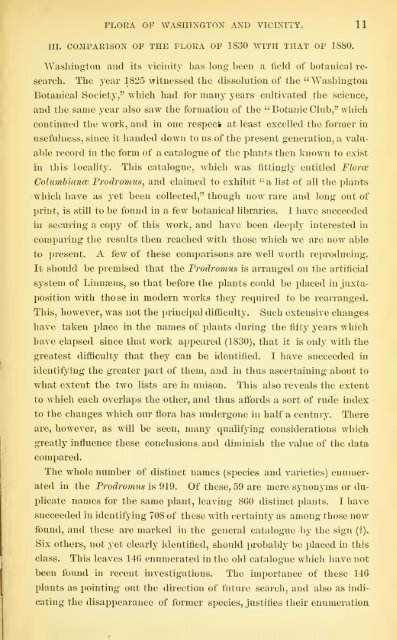Bulletin - United States National Museum - Smithsonian Institution
Bulletin - United States National Museum - Smithsonian Institution
Bulletin - United States National Museum - Smithsonian Institution
You also want an ePaper? Increase the reach of your titles
YUMPU automatically turns print PDFs into web optimized ePapers that Google loves.
FLORA OF WASHINGTON AND VICINITY. 11<br />
III. COMPARISON OF THE FLORA OF 1830 "WITH THAT OF 1880.<br />
Washington and its vicinity has long been a field of botanical re-<br />
search. The year 1825 ^ritnessed the dissolution of the " Washington<br />
Botanical Society," which had for many years cultivated the science,<br />
and the same year also saw the formation of the "Botanic Club," which<br />
continued the work, and in one respect at least excelled the former in<br />
usefulness, since it handed down to us of the present generation, a valu-<br />
able record in the form of a catalogue of the plants then known to exist<br />
in this locality. This catalogue, which was fittingly entitled Florae<br />
Columbiance Prodromus, and claimed to exhibit " a list of all the plants<br />
which have as yet been collected," though now rare and long out of<br />
print, is still to be found in a few botanical libraries. I have succeeded<br />
in securing a cojjy of this work, and have been deeply interested in<br />
comparing the results then reached with those which we are now able<br />
to present. A few of these comparisons are well worth reproducing.<br />
It should be premised that the Frodromns is arranged on the artificial<br />
system of Linnseus, so that before the plants could be placed in juxta-<br />
position with those in modern works they required to be rearranged.<br />
This, however, was not the principal difficulty. Such extensive changes<br />
have taken place in the names of i^lants during the fifty years which<br />
have elapsed since that work appeared (1830), that it is only with the<br />
greatest difficulty that they can be identified. I have succeeded in<br />
identifying the greater part of them, and in thus ascertaining about to<br />
what extent the two lists are in unison. This also reveals the extent<br />
to which each overlaps the other, and thus affords a sort of rude index<br />
to the changes which our flora has undergone in half a century. There<br />
are, however, as will be seen, many qualifying considerations which<br />
greatly influence these conclusions and diminish the value of the data<br />
comj)ared.<br />
The whole number of distinct names (species and varieties) enumer-<br />
ated in the Frodromus is 919. Of these, 59 are mere synonyms or du-<br />
plicate names for the same plant, leaving 860 distinct plants. I have<br />
succeeded in identifying 708 of these with certainty as among those now<br />
found, and these are marked in the general catalogue by the sign (t).<br />
Six others, not yet clearly identified, should probably be placed in this<br />
class. This leaves 146 enumerated in the old catalogue which have not<br />
been found in recent investigations. The importance of these 146<br />
plants as pointing out the direction of future search, and also as indi-<br />
cating the disappearance of former species, justifies their enumeration

















